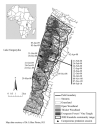The Appearance and Spread of Ant Fishing among the Kasekela Chimpanzees of Gombe: A Possible Case of Intercommunity Cultural Transmission
- PMID: 25242820
- PMCID: PMC4166518
- DOI: 10.1086/666943
The Appearance and Spread of Ant Fishing among the Kasekela Chimpanzees of Gombe: A Possible Case of Intercommunity Cultural Transmission
Abstract
Chimpanzees exhibit cultural variation, yet examples of successful cultural transmission between wild communities are lacking. Here we provide the first account of tool-assisted predation ("ant fishing") on Camponotus ants by the Kasekela and Mitumba communities of Gombe National Park. We then consider three hypotheses for the appearance and spread of this behavior in Kasekela: (1) changes in prey availability or other environmental factors, (2) innovation, and (3) introduction. Ant fishing was recognized as habitual in the Mitumba community by 1992, soon after their habituation began. Apart from one session in 1978, Camponotus predation (typically with tools) was documented in the Kasekela community beginning only in 1994, despite decades of prior observation. By February 2010, ant fishing was customary in Kasekela and with one exception was practiced exclusively by chimpanzees born after 1981 and immigrant females. We hypothesize that changes in insect prey availability over time and/or the characteristics of one popular ant-fishing site may have influenced the establishment of ant fishing. Though innovation cannot be completely ruled out, the circumstantial evidence suggests that a Mitumba immigrant introduced ant fishing to Kasekela. We submit that this report represents the first documented case of successful transmission of a novel cultural behavior between wild chimpanzee communities.
Figures





References
-
- Agosti D, Majer JD, Alonso LE, Schultz TR. Ants: standard methods for measuring and monitoring biodiversity. Smithsonian Institution; Washington, DC: 2000.
-
- Altmann J. Observational study of behavior: sampling methods. Behaviour. 1974;49:227–267. - PubMed
-
- Andersen AN, Majer JD. Ants show the way down under: invertebrates as bioindicators in land management. Frontiers in Ecology and the Environment. 2004;2:291–298.
-
- Andow DA. Vegetation diversity and arthropod population response. Annual Review of Entomology. 1991;36:561–586.
-
- Biro D. Clues to culture? the Coula and Panda-nut experiments. In: Matsuzawa T, Humle T, Sugiyama Y, editors. The chimpanzees of Bossou and Nimba. Springer; Tokyo: 2011. pp. 165–173.
Grants and funding
LinkOut - more resources
Full Text Sources
